
Alaria marginata
Ribbon Kelp, Winged Kelp
Interactions conducted: 9 July 2021, start time 09:00 PDT
Harling Point, Juan de Fuca Strait, B.C., Canada.
Tide: 1.0 foot tide 10:02 PDT (measured at Oak Bay Tidal Station)
Conditions: Clear, no precipitation, wind West 0 – 5 km/hr, sea smooth, low irregular SW swell, 15˚C, relative humidity 86%.
Phase of Moon: New Moon (approx. 9 hours prior to this phase at time of interaction); (Previous Phase, Third quarter, 1 July 2021 at 2:10pm PDT: Next Phase, New Moon, 9 July 2021 at 6:16pm PDT.)
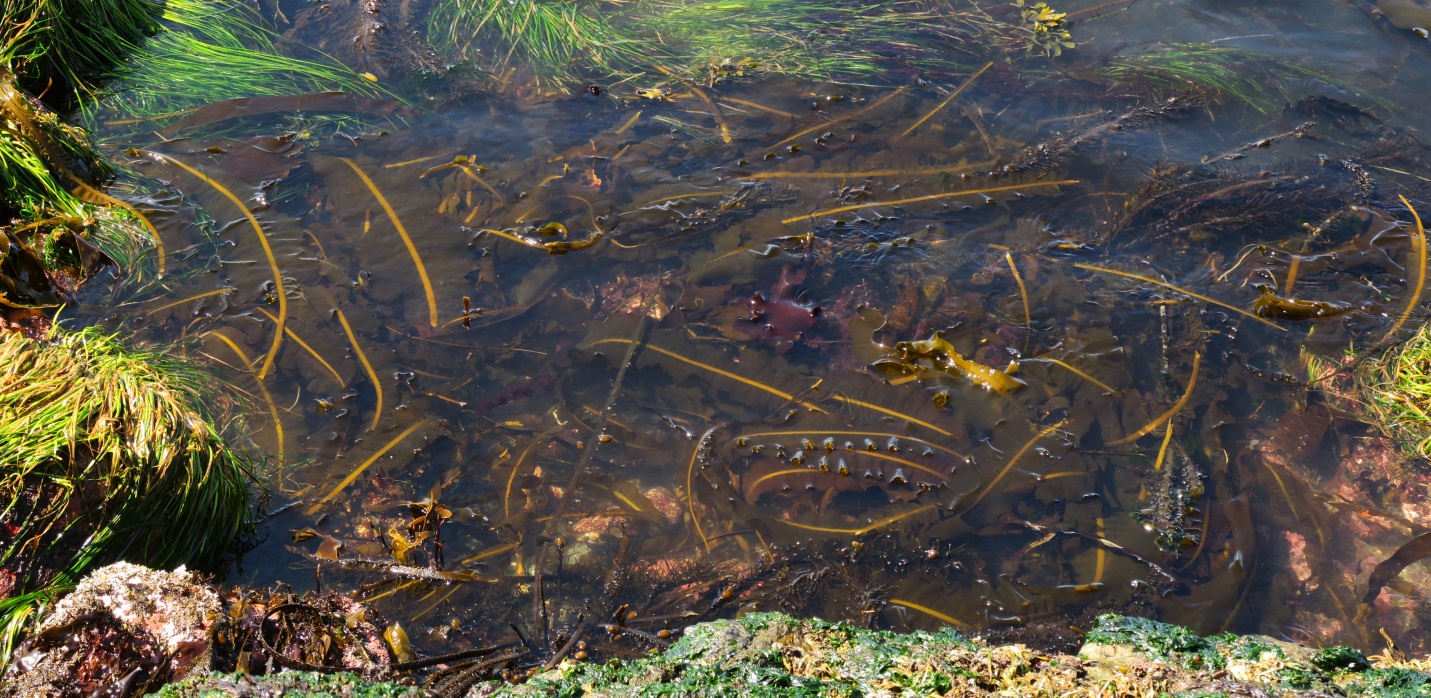
Figure 1: Shoreline grouping of Alaria marginata seen just below the water’s surface on a calm summer day with its yellow midribs marking it brightly. Mazzaella splendens and Egregia menziesii are also growing in this habitat. Outer coastline Gonzales Bay, Juan de Fuca Strait, B.C., Canada. July 11, 2021. Photo ID 27349 ©Seaweedwhisperings.com
Person 1:
This seaweed friend is located mainly in small surge channels.
Your 1.5 centimeter central yellow green olive rib gives you away. The rest of your parts are indistinct or obscured by other seaweeds.
I know there is more to you but I’ll have to look deeper. (I know there is more to you based on previous experience, such as I know there are ‘wings’ near your base).
Along each side of the rib are rippled surfaces perpendicular to the rib. Does this help you undulate and enable you to weave amongst, and survive the more dominant Egregia? [Egregia menziesii is another kelp species growing adjacent here at this location.]
Blades are up to 3 meters long but no more than 10cm broad in most; some are up to 20cm broad.
I’m using pronouns such as “you” and “your” much more than I usually do. Am I deferring or being submissive to your authority? There was a presence, a strength there, which I am sensing and calling “your authority”.
Are you showing only what you want to show me?
I pulled a couple of thalli out of the water for a closer look.
The rib is very strong, although only a few millimeters thick. The blade is olive green in coloration.
I noticed immediately that Alaria wants to retract / retreat back to the sea (when I attempt to pull it out of the water). Uncomfortable outside of its element?
What’s there to hide? Something real? Or is it fantasy?
Fear? Insecurity?
I sense that you can be sneaky.
I broke the rib with my thumbnail in a couple of spots. It snapped crisply with a loud crackly sound.
Tasted the rib – it was crisp and had a slight mushroom flavor. The blade was relatively tasteless.
Contrasting with the rib, the blade is difficult to break or tear, it is very stretchy.
Alaria doesn’t seem to have been impacted by recent heat wave (including record daytime highs of 40˚C when the normal highs are only 21˚C at this season), perhaps they were only exposed a short while.
Clusters of stipes emanate from a many branched hapterous holdfast.
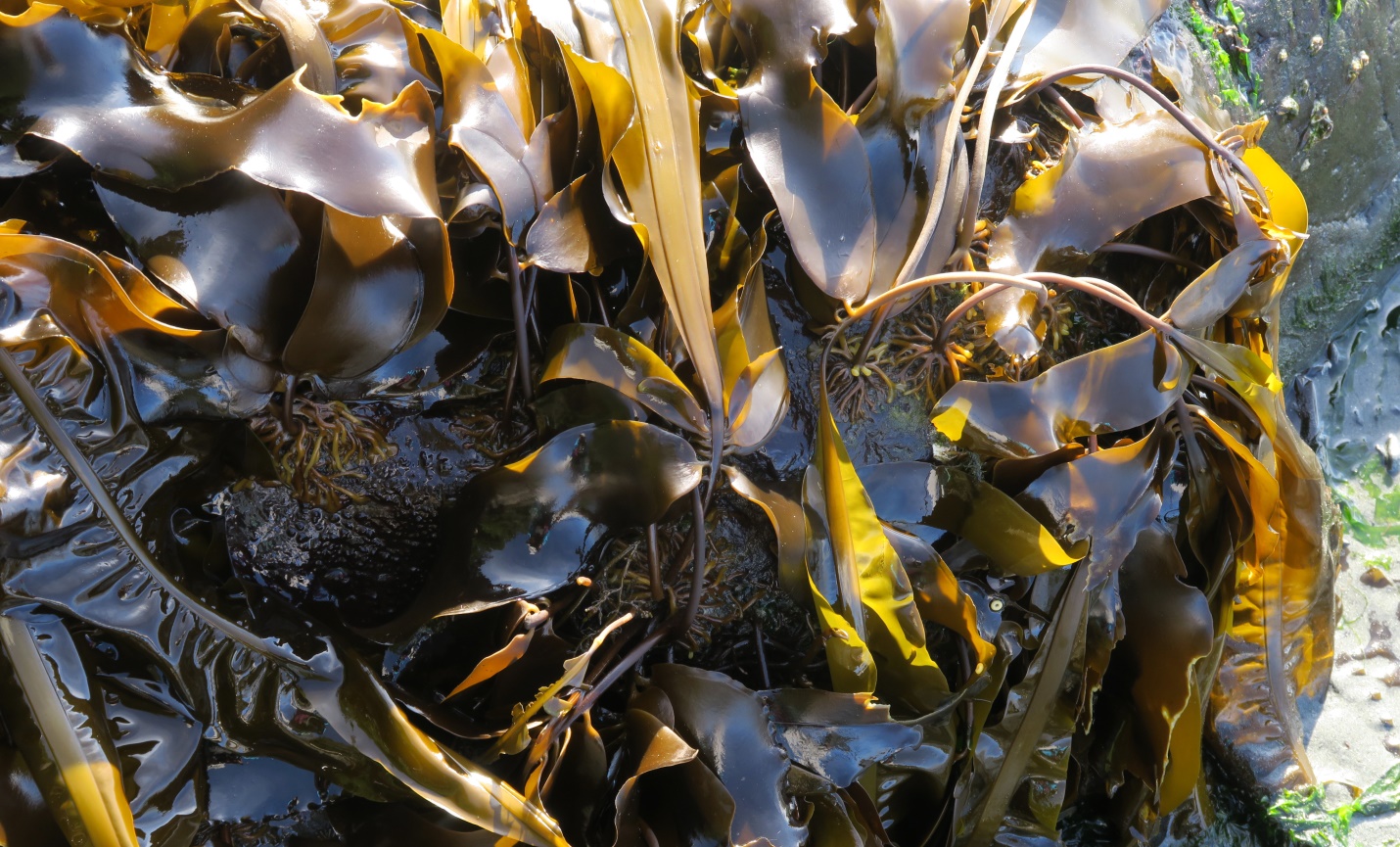
Figure 2: A large boulder is populated thickly with Alaria marginata; the finger-like haptera can be seen which anchor the round stipes firmly in place, and at the middle of this grouping a set of “wings” is visible, too. Fishboat Bay, Juan de Fuca Strait, B.C., Canada. July 24, 2021. Photo ID 27350 ©Seaweedwhisperings.com
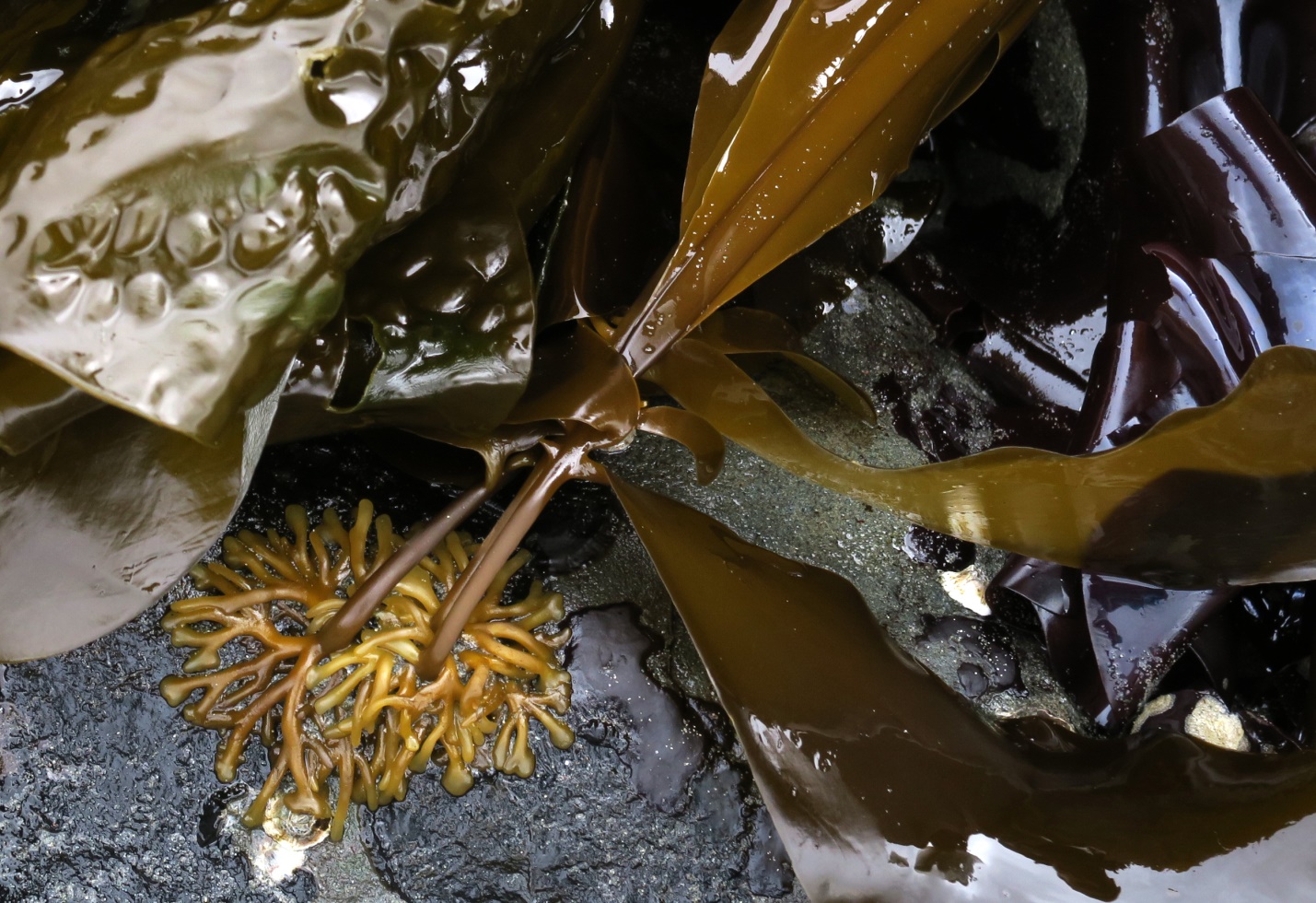
Figure 3: A closer view of the haptera holdfast for three Alaria marginata individuals. Had we not peeled back the Sea Cabbage blades (greener and bullate-covered) to the left, and the Splendid Iridescent Seaweed blades (silky smooth deep burgundy) to the right, these structures of the Ribbon Kelps would have been unseen. Fishboat Bay, Juan de Fuca Strait, B.C., Canada. June 8, 2020. Photo ID 27351 ©Seaweedwhisperings.com
Person 2:
Alaria – anchored to bedrock with strong and slender looking haptera.
From the holdfast arises a slender but strong cylindrical stipe.
Only approximately 4 cm from holdfast this stipe flattens out and here growing on opposite sides are your “wings”.
The wings are short oval blades that grow perpendicular to the stipe/rib of this kelp and the bases of these wings are tilted up on a right angle / opposite plane to the plane of the long slender flattish blade. The wings are all olive brown green like the rest of you – 5 or 6 on either side of most of you. Wings are lined up neatly, overlap each other, like a venetian blind, at their origin close to the stipe.
The wings are tougher looking and thicker than the main blade.
From here your stipe widens into a modest sized but distinct rib, and then you have wider “leafy” parts on both sides.
My word use is clumsy, not ‘right’ in these notes of mine today, my usual descriptive skills are not available to me; is the energy of this seaweed one that is somewhat clumsy in speaking or weak with written language…? Does it communicate better with something other than language? It feels like other communication modes may be preferred in Alaria marginata such as gestural or spatial (important modes in animals, for instance)?
The rib is very smooth and strong.
The ‘leafy parts’ are very, very silky, smooth, strongly and mainly flat with a lot of ruffling at the rib which ruffle the whole blade.
[“Yes, this language is awful”, Person 1, agreed! As he was dictating from my field book so I could type up this report, he was humored by my clumsy word usage.]
I tried to photograph your holdfast and wings, Alaria – I got frustrated. They are not easy to access and Person 1 had already started his immersion, was writing his notes, and here I am still documenting with photos. I was “swamped” with the feeling of, “ARGHHH, I can’t do it all!”
That feeling is not one I often confront; typically I can do it all (or at least “all” that I set out to do). Is this seaweed not at all like me, then? Working with its energy today I feel pressured, as if I’m falling behind, and I must strive to keep up, struggling to fit into a mode that is out of sync with my own.
Even at very low tides, Alaria, you are mostly immersed in the ocean (only your holdfast, your stipe base and a few wings are out of water).
I see ribbons of you moving gracefully with the water.
You need to stay in harmony with the water movement – that is how all goes well for you.
At slightly higher intertidal levels, a matter of only a few centimeters, the harmony you prefer was broken and waves and wind (or some other combination of the elements) seem to have ripped your blades away. All that is left of you is your holdfast, your cylindrical stipe base, and a few broken wings.
Can you take ‘flight’ with only some of your wings, or on broken wings?
Is your last flight, when you are broken away from your holdfast, useful or significant in a life history function? Does it help you colonize new areas?
Or are your wings actually some kind of rudder, a set of them that helps create that graceful movement of yours in the water?
The wings actually look also like flippers of marine mammals.
Are they to guide or regulate propulsion?
I don’t think I really ‘understand’ your wings, Alaria, not yet at least, perhaps one day...
“Oops, I’m going to end up in the drink here”, I said out loud while trying to position myself to make more photos of Alaria.
“It is quite treacherous!” Person 1 stated.
Discussion on this point (while transcribing our field notes): I, Person 1, am very aware, when I’m in the wilderness, of the environment around me, particularly of potential dangers. And to me, you (Person 2) are not. That’s my perception. I feel a kind of “tension” to look after myself and those around me, to warn them of hazards or danger.
It was clear to us that Alaria marginata has this same awareness, being alert for danger / hazards.
On with the field notes now:
Tasted a piece of the rib; I had to bend it very firmly, then it tore, the tear runs along the length of the rib, easily cutting it. Chewing the rib, I found it had a very cellulose-like texture, certainly for a seaweed (I can’t think of another seaweed I’ve yet tasted that had such a cellulose fibre quality to it).
After the initial salty taste goes away, I taste a pleasant woody mushroom flavor. Finish is that of stringy cellulose mass that I did not want to swallow.
The largest Alaria here today have 13 cm of blade either side of the 1.5 cm wide rib; that same proportion, although reduced in total size, is played out in smaller / younger blades. Long and slender; a graceful look.
The “wings” (rudders / flippers) hide or are kept hidden. You wouldn’t find them without tracing the rib all the way down to its holdfast. They blend in with the overall coloration of this seaweed and are very easily not observed.
The “ribbons” are what you see; long blades of gently ruffled kelp. Yellowish in contrast to the rest of this seaweed, the ribs also stand out rather prominently.
I think you like to keep parts of yourself hidden, just as much as you have a strong urge to be in motion with the water. Both these traits lead me to conclude that I can’t pin you down.
You are a slippery one, Alaria!
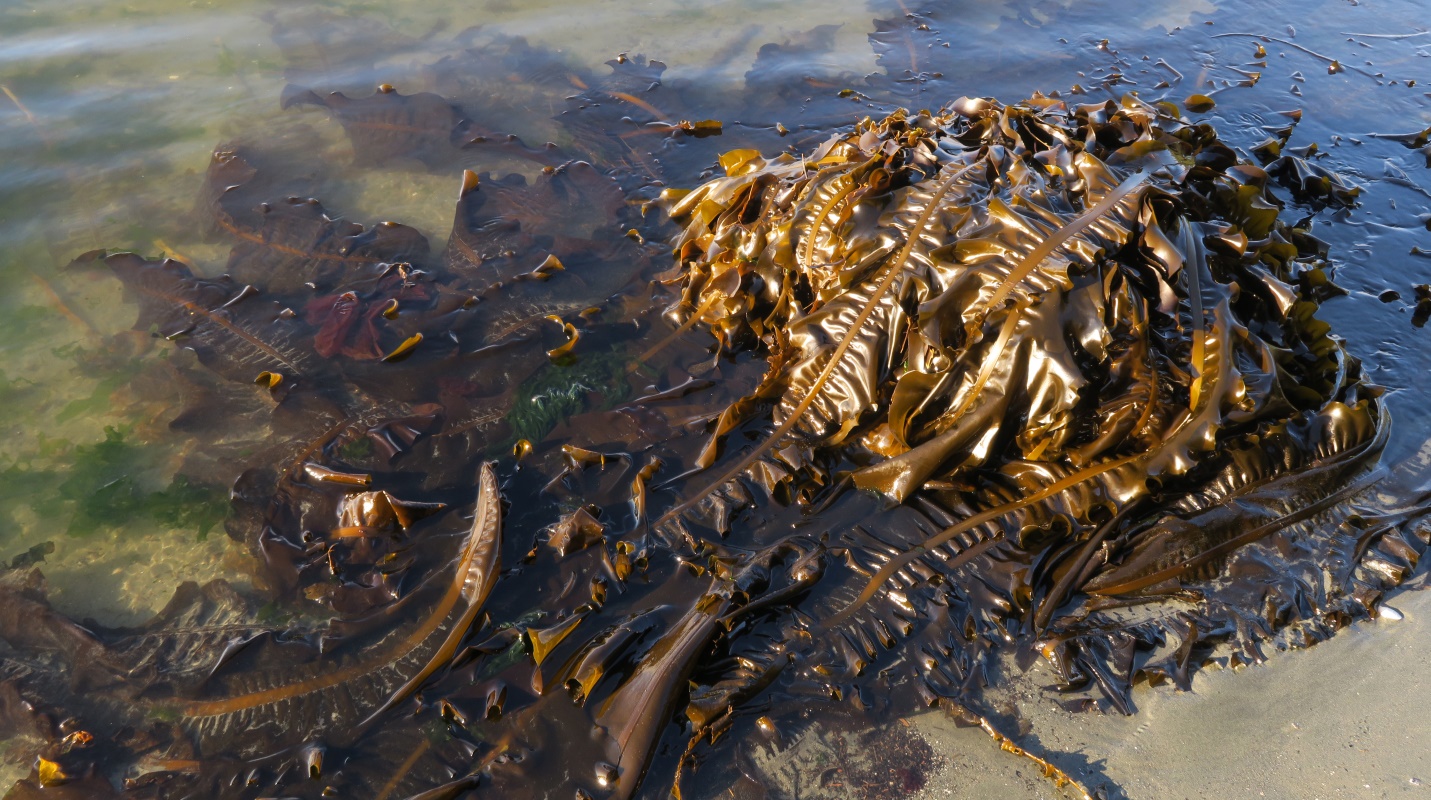
Figure 4: On this very low tide day this typically subtidal boulder is exposed to view. Alaria marginata has obviously found this to be an ideal habitat as the size and number of blades growing here is notable. The ruffling of the blades all along the distinctive midribs is plainly visible and underwater this is highlighted by the settling of sand in the grooves. Fishboat Bay, Juan de Fuca Strait, B.C., Canada. July 24, 2021. Photo ID 27352 ©Seaweedwhisperings.com
Discussion:
This trait that Person 1 identified, the “tension” to look after himself and others as pertains to his sense of potential danger and/or hazards, it is something very familiar to both of us. How I understand it is that Person 1 cannot comfortably understand how others may rely on their strength or agility for their safety, because he relies on going mainly with “momentum”. He often moves by swinging his body and using the advantage of the force of momentum, and he assiduously avoids ‘colliding’ (a collision when you have momentum behind your mass is much more damaging of course). Person 1 agreed when I pointed this out, saying, “I don’t very successfully fight, which is basically using strength”.
We explored this aspect so fully because this trait is part of Alaria marginata’s energy, too; it doesn’t “fight” very successfully either – at least NOT by using strength. Instead, it seems that this is how it broke or was damaged. In many places we could identify where numerous Alaria stems were broken and this seemed to be a tide levels that were more susceptible to the “fight” or “collision” factor. In areas where the Alaria thalli were immersed in the sea water (at lower intertidal levels) the thalli were much more intact, predominantly so, in fact.
So, Alaria chooses to “go with” the water, “go with” the wave action, “go with” momentum and it does NOT like to fight. It innately knows loss and injury is the likely result of that. References confirm that Alaria marginata lives in the mid to low intertidal in exposed habitats and in semi-protected areas only if there is sufficient current. This confirms that urge or compulsion to move with the current that we sensed in Alaria – that it needs to work with a moving force, and also that while it can withstand certain wave energies, there is a breaking point and that breaking point seems to be if Alaria is ‘forced to fight’ the powerful wave energy.
A review of literature confirmed that the sporophylls, the “wings” of Alaria are reproductive structures. We had pondered, since we likened them to wings, or rudders or flippers, if they had some link to the “propulsion” of Alaria marginata. While the link is not direct, except if you think in terms of generations, the concept of propulsion – driving or pushing forward, feels highly significant to this species. Something about Alaria’s energy is very much concerned with driving and pushing forward, and it seems, Alaria, that you are clever about this. You align yourself with more powerful forces and thereby do not need brute strength; instead you need keen awareness of the forces available to you and the ways in which you can safely partner with them.
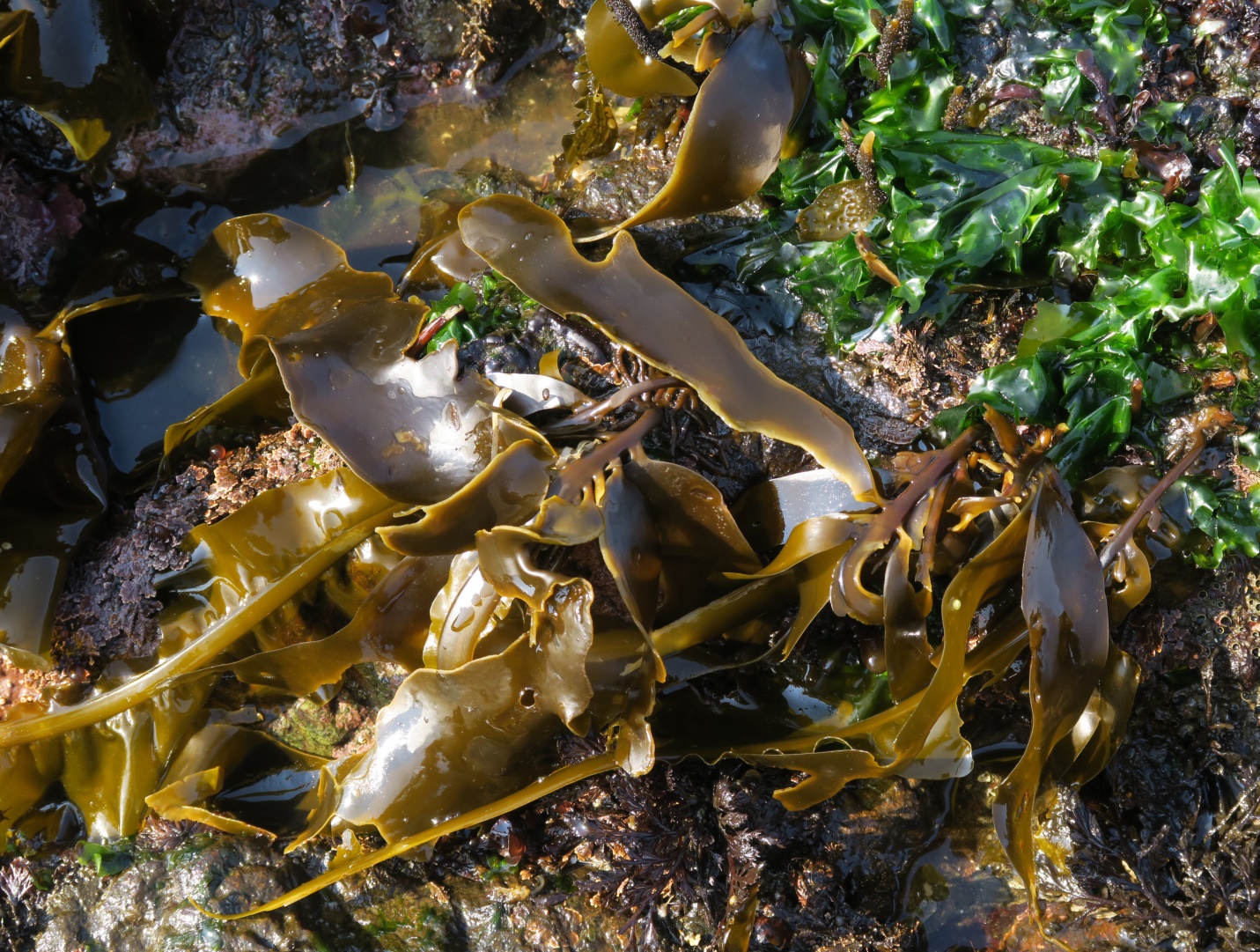
Figure 5: Pictured here are several Alaria marginata individuals that have suffered damage; blades are torn away and some wings are battered, but many wings and the holdfast and stipe base remain firmly in place. Harling Point, Juan de Fuca Strait, B.C., Canada. July 9, 2021. Photo ID 27353 ©Seaweedwhisperings.com
Biology & Natural History Information:
Description:
Ribbon Kelp is named for having conspicuous wing-shaped reproductive blades (sporophylls) near the upper portion of the stipe (closer to the blades than the holdfast). Up to 20 to 40 of these sporophylls form two rows along the upper part of the stipe below the blade; they form in spring and thicken with maturity. The stipe which is cylindrical near the base but flattened near the blade can reach lengths up to 30 cm in total. The thin brownish to olive green blade is lance-shaped, grows to 3 meters in length, and has a conspicuous and lighter colored midrib that extends from the stipe and all along the length of the blade. The relatively small holdfast is well developed and is composed of many branches (haptera). Alaria marginata is considered an annual as its blades and sporophylls erode by the end of the summer, leaving only the holdfast and stipe which can overwinter, but will rarely regrow.
Habitat:
Ribbon Kelp grows on rocks in the mid to low intertidal, and sometimes the upper subtidal. It does well in exposed habitats and will also grow in semi-protected areas provided there is sufficient current.
Distribution:
This kelp species is found from Aleutian Islands, Alaska to Point Conception, California.
Remarks:
Recent research suggests that there is only one species of Alaria in the Pacific Northwest when there were once thought to be seven very similar species in this genus. Most of those seven species are now understood to be Alaria marginata which indicates that this species exhibits notable morphological variation within its range dependent on its local environment. Even the reproductive sporophylls will display various sizes and shapes.
The sporophylls of this kelp species contain chemicals that discourage browsing by herbivores, meaning any browsing on this seaweed usually leaves the reproductive portion still viable. Sitka black tailed deer have been observed grazing on Ribbon Kelp when large snowfalls force them to feed in the intertidal zone.
Ribbon Kelp is a popular edible species. Healthy specimens are a good source of vitamins K and B6 as well as iodine and protein. Ethical harvesting involves taking only some of the tips of each frond, thereby leaving the blade both photosynthetic and reproductive viability.
Former name(s): Alaria valida Kjellman et Setchell.
Classification:
Phylum: Ochrophyta
Class: Phaeophyceae
Class: Phaeophyceae
Order: Laminariales
Family: Alariaceae
Genus: Alaria
Species: Alaria marginata Postels & Ruprecht 1840
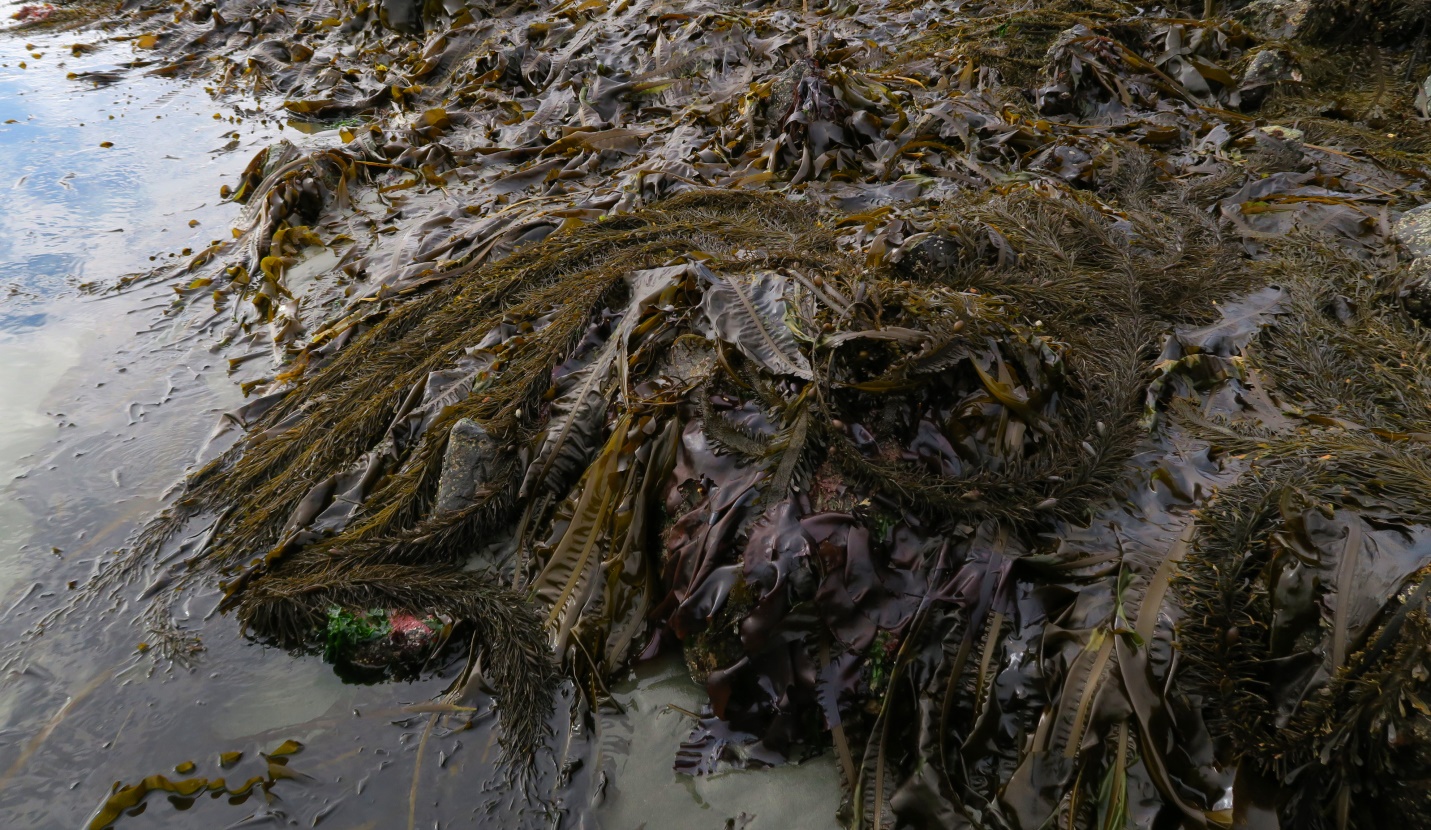
Figure 6: A larger expanse of coastline is pictured here and the mix of large macroalgae consists mainly of Alaria marginata, Egregia menziesii and Mazzaella splendens. The out-of-water arrangement of these long kelps, the Ribbons and Feather Boas, reflects how they interact when submerged. The Feather Boa has air bladders that keep it just under, but lifted very close to the water’s surface, while Alaria marginata has no such flotation mechanism; it then moves a little lower in the water, and the much shorter Mazzaella blades, well, they fill in underneath. Fishboat Bay, Juan de Fuca Strait, B.C., Canada. July 6, 2020. Photo ID 27354 ©Seaweedwhisperings.com
![]()